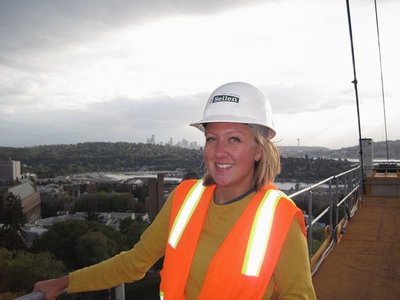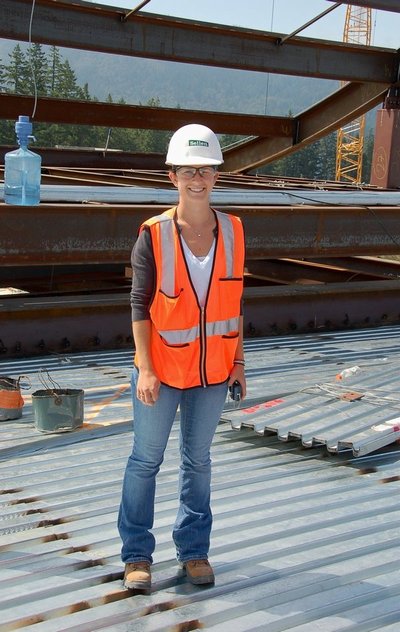August 19, 2010
Site work brings UW Construction Management interns back to campus
When Holly Nichols graduated from the UW in 2009, she didn’t know she’d be back on campus soon after. No, Nichols is not a graduate student, nor does she work for the University. She’s an employee of Sellen Construction, and she spent a lot of time on campus over the last year working on Paccar Hall, the new business school building that was recently completed.
Nichols’ degree is in construction management, a program that requires all its graduates to do an internship. She interned at Sellen, working on the company’s office and condo project in South Lake Union. Then when she graduated and took a full-time job at Sellen, she was thrilled to be assigned to the Paccar Hall project.
Not all graduates of construction management find themselves back on campus, but as the University continues putting up new buildings, it’s a distinct possibility. Certainly all graduates hope to land in a construction project somewhere, and the internship is a key part of making that happen.
“The primary purpose of the internship is to give students an opportunity to have real hands-on experience in the field, which provides a context for the things they’re going to study in class their senior year,” said John Schaufelberger, who heads construction management. “It also helps them when they look for a job because then they have some work experience.”
“We learn a lot in the classroom, but seeing stuff in the field is a whole different ballgame,” Nichols said. “You can look at a drawing of something, but it doesn’t really tell you how it’s installed or how much time it takes or who needs to be there. That all comes from experience.”
The Construction Management Program doesn’t dictate what the internship should be, Schaufelberger said. Students work in diverse settings, from construction companies to state agencies to specialized companies that are often subcontractors on construction projects, so the program encourages students to sit down with their internship supervisors and work out a plan unique to that setting.
Students and their employers are, however, given some written guidelines from the program, including a list of possible tasks a student might complete. Companies vary in how formal their internship program is; the one that Nichols encountered at Sellen was carefully designed and encapsulated in a workbook that every intern receives. Sellen offers two educational sessions — one that introduces the company and the role of the project engineer (the title construction management graduates generally start with in the business) and one that discusses sustainability and the software programs Building Information Modeling and Computer Aided Design.
In addition, interns must fill out worksheets that ask them to complete tasks such as drawing an organizational chart for their project team or participating in reviewing a series of requests for information and assessing their impact to the project’s cost and schedule. After the task is completed, there are reflective questions for them to answer. Each intern hosts a jobsite tour for other interns focusing on work he or she has done, and each spends a couple of days job shadowing people in the field, such as surveyors; or partners in the project, such as architects. At the end of the internship, each intern gives a presentation that is attended by not only other interns, but also team members from the job site and others involved in the project.
The Sellen plan was created largely by Carrie Boettcher, also an alum of UW Construction Management who is currently Sellen’s training and development manager. “A lot of the program comes out of what I wish had been there for me when I was starting,” Boettcher said. “In days past, there was something of a sink or swim approach, but there’s some basic stuff we can present to interns that can help create a big picture understanding of what’s going on during a construction project. What we’re trying to do is create a solid foundation for the interns, wherever they might go after they finish.”
Sellen and other companies recruit interns during a career fair that Construction Management sponsors in November. Between 20 and 30 companies attend that fair, Schaufelberger said, looking for both employees and interns. Boettcher said her company interviews more than 100 students from UW and other schools and usually chooses between five and 10 interns for the summer program. The current poor economy has put a damper on hiring, however, meaning that fewer companies are offering internships and those that do are offering fewer.
Alex Angier, another Construction Management student who is doing her internship this summer, has found the experience exciting. “There’s only so much you can talk about in class and the labs,” she said. “For example, we have estimating classes in which we learn to estimate costs for, say, a concrete slab. But then we went to a scheduling class and we had to estimate the time needed to pour a concrete slab and we had no idea because we’d never seen a slab go in. We didn’t know how many people it took, or what weather conditions really affect it. That’s where the two really complement each other.”
As part of her field experience this summer, Angier chose to spend a day pouring concrete at the Swedish Hospital site she’s working on in Issaquah.
Schaufelberger said the internship experience provides the necessary background for the capstone project students have to complete in their senior year. They are given a construction project for which they do an estimate, a schedule and a project management plan. They put together a proposal and do a 20-minute presentation for a jury of industry people.
“That’s where they put everything they’ve learned together,” Schaufelberger said.
As women, Nichols and Angier are in the minority in Construction Management. Nichols’ class had 50 men and eight women; Angier’s has 61 men and six women. But both say they have not experienced prejudice, either in class or on the job.
“If you can do the work, you will be accepted,” Nichols said. She started school intending to be an architect, but was disappointed with an architecture internship and decided to do a dual program. “Construction is high energy; it’s always changing,” she said.
As for Angier, she’s the daughter of a developer and has been around construction her whole life. “It’s pretty amazing to work on something that’s all plans on paper; then you look outside and it’s right there,” she said. She hopes to get a job like Nichols’ when she graduates.
And Nichols is really excited about her next project. She’s been assigned to work on the replacement for Balmer Hall, which will keep her on campus for another two years.


